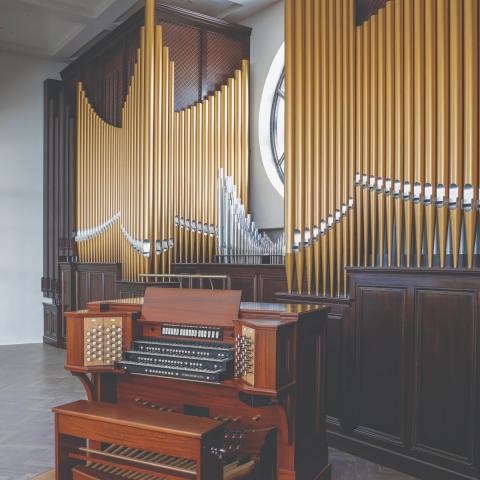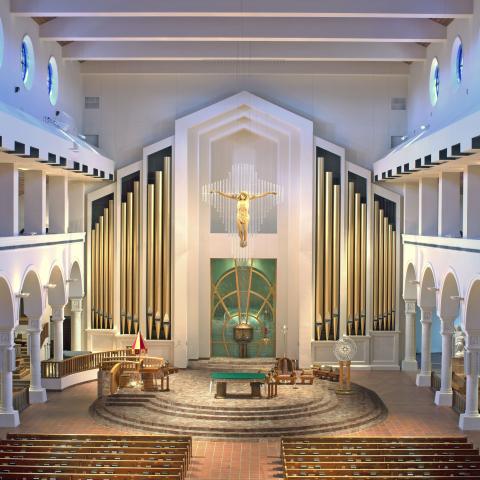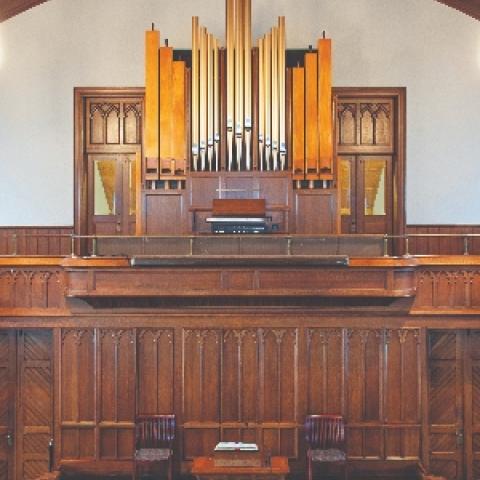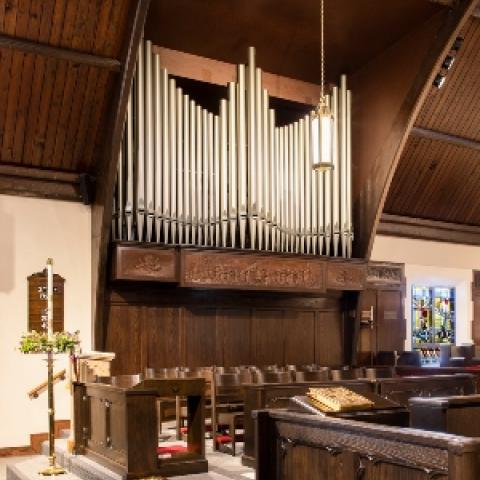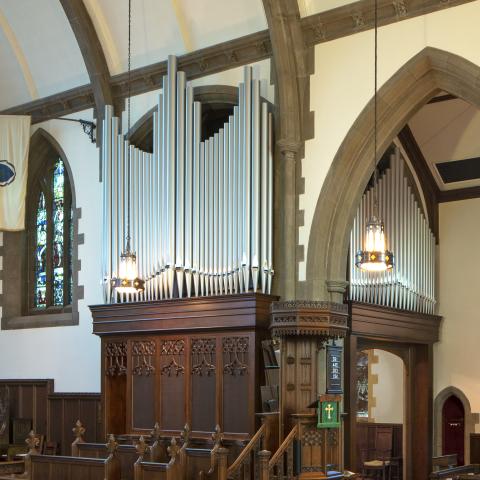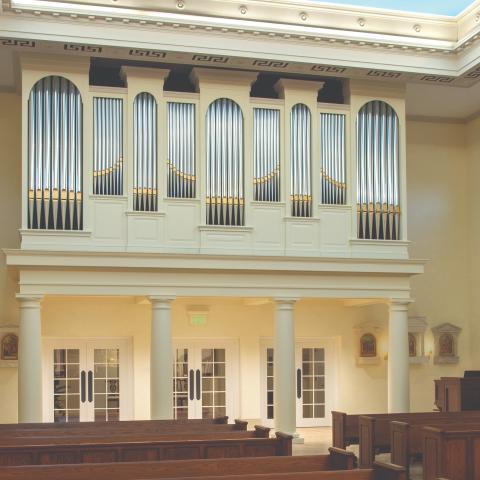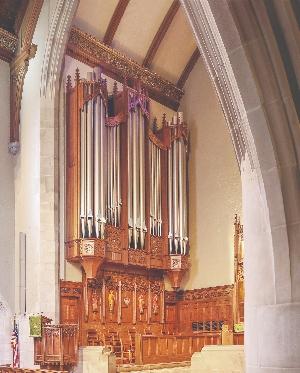
Schoenstein & Co., Benicia, California
First United Methodist Church, Montgomery, Alabama
When an organ builder approaches a new project there are many challenges, and acoustical environment is generally the most difficult. A good deal of credit for a beautiful musical instrument must go to the room that shapes its sound; likewise, a poor acoustic can limit the potential of even the best-designed organ.
We were delighted by the grand proportions of First United Methodist Church, Montgomery, Alabama, but its acoustical effect was disappointing. The church engaged Paul Scarbrough of Akustiks, Norwalk, Connecticut, to improve the acoustic profile. A detailed and lengthy study resulted in recommendations that were practical—achieving maximum result for time and money spent.
A great deal of credit for the success of our instrument goes to the organ committee and musicians for insisting on implementing the improvements. The key was to improve the reflection of the nave side walls. This created a more even, warm acoustic for the organ and for all music by increasing the reflection of sound during and immediately after it is produced. These considerations are far more important than long reverberation time. The room is now balanced acoustically, looks appealing, and serves myriad uses.
The musicians of First United Methodist Church were supportive clients who trusted our vision for the organ. The church’s long history of great music includes lots of organ-accompanied choral repertoire, and the congregation carries on the Methodist tradition of robust hymn singing. We designed the organ around these two primary musical needs. The Great division contains multiple diapasons to support the congregation, and a large Swell division with double-enclosure gives more expressive control for accompanying. The Choir division is housed in a shallow, tall chamber, requiring a two-level design with pipes arranged carefully for tuning stability and easy maintenance. This is also where the 16′ Bourdon of the organ resides, allowing the bass tone to be brought down to ppp under the whisper stops across the chancel in the Swell.
The team at First Church—music director James Seay, assistant director and organist Joshua Coble, and consultant Andrew Risinger—recognized that the best way to achieve a truly wonderful organ sound is excellent acoustics. We hope the new organ and resonant church serve this congregation for generations to come.
—Bryan Dunnewald
Schoenstein & Co.
Photo credit: Louis Patterson
GREAT (Manual II)
16′ Double Open Diapason 61 pipes
8′ First Open Diapason 61 pipes
8′ Second Open Diapason 12 pipes (ext 16′ Double Diapason)
8′ Harmonic Flute 61 pipes
8′ Salicional (Choir)
8′ Lieblich Gedeckt (Choir)
4′ Principal 61 pipes
4′ Lieblich Gedeckt (Choir)
2-2⁄3′ Sesquialtera II 115 pipes
2′ Fifteenth 61 pipes
2′ Mixture IV 201 pipes
16′ Ophicleide (Choir)
8′ Tuba (Choir)
8′ Solo Trumpet (Choir)
Chimes (digital)
Great Unison Off
SWELL (Manual III, enclosed)
16′ Contra Gamba (ext 8′) 12 pipes
8′ Open Diapason 61 pipes
8′ Stopped Diapason 61 pipes
8′ Echo Gamba 61 pipes
8′ Vox Celeste 61 pipes
8′ Cor Seraphique† 61 pipes
8′ Voix Angelique (TC)† 49 pipes
4′ Gemshorn 61 pipes
4′ Harmonic Flute 61 pipes
2′ Octavin 61 pipes
2′ Mixture III–V† 236 pipes
16′ Posaune† 61 pipes
8′ Trumpet† 61 pipes
8′ Posaune (ext 16′)† 12 pipes
8′ Oboe 61 pipes
4′ Clarion† (ext 16′) 12 pipes
Tremulant
Swell 16′
Swell Unison Off
Swell 4′
†On high pressure under double expression
CHOIR (Manual I, enclosed)
16′ Bourdon 24 pipes
8′ Salicional (Bourdon bass) 49 pipes
8′ Unda-Maris (TC ) 49 pipes
8′ Lieblich Gedeckt 49 pipes (Bourdon Bass)
4′ Salicet (ext 8′) 12 pipes
4′ Lieblich Gedeckt (ext 8′) 12 pipes
2-2⁄3′ Twelfth (TC, fr Nineteenth)
2-2⁄3′ Nazard (fr Lieblich Gedeckt)
2′ Fifteenth (ext 4′ Salicet) 12 pipes
1-3⁄5′ Tierce (TC) 42 pipes
1-1⁄3′ Nineteenth 54 pipes
16′ Ophicleide† (ext 8′) 12 pipes
8′ Tuba† 61 pipes
8′ Solo Trumpet†† 61 pipes
8′ Corno di Bassetto 61 pipes
8′ Oboe (Swell)
Tremulant
Choir 16′
Choir Unison Off
Choir 4′
Cymbelstern
†High pressure
††Retained from previous organ, unenclosed with Great
GALLERY (floating)
8′ Open Diapason 49 pipes (Chimney Flute bass)
8′ Chimney Flute 61 pipes
8′ Dulciana 49 pipes (Chimney Flute bass)
4′ Principal 61 pipes
4′ Chimney Flute (ext 8′) 12 pipes
PEDAL
32′ Resultant
16′ Open Metal 32 pipes
16′ Diapason (Great)
16′ Gamba (Swell)
16′ Bourdon (Choir)
8′ Principal 12 pipes
8′ Flute (Great)
8′ Stopped Diapason (Swell)
4′ Fifteenth 12 pipes
4′ Flute (Great)
32′ Contra Posaune (ext Sw) 12 pipes
16′ Ophicleide (Choir)
16′ Posaune (Swell)
8′ Tuba (Choir)
8′ Posaune (Swell)
4′ Corno di Bassetto (Swell)
8′ Solo Trumpet (Choir)
Chimes (Great)
Couplers
Great to Pedal
Great to Pedal 4′
Swell to Pedal
Swell to Pedal 4′
Choir to Pedal
Choir to Pedal 4′
Swell to Great 16′
Swell to Great
Swell to Great 4′
Choir to Great 16′
Choir to Great
Choir to Great 4′
Swell to Choir 16′
Swell to Choir
Swell to Choir 4′
Great to Choir
Choir to Swell
Gallery on Great
Gallery on Swell
Gallery on Choir
Gallery on Pedal
All Swells to Swell
Manual I/II Transfer
All Divisionals Become Next
MECHANICALS
Solid State capture combination action:
• 5,000 memories
• 56 pistons and toe studs
• 6 reversibles including Full Organ
• Programmable piston range
• Piston sequencer
Record/Playback system
Electro-pneumatic action
33 voices, 41 ranks, 2,423 pipes
Builder’s website: schoenstein.com
Church website: fumcmontgomery.org

